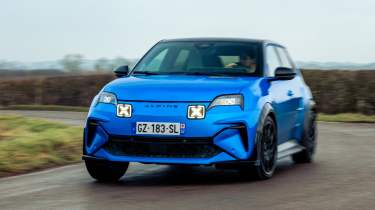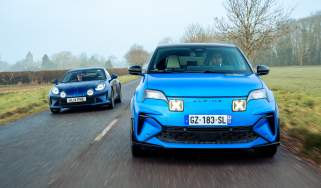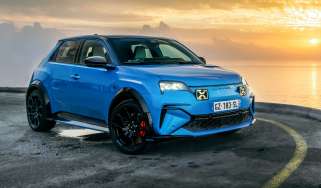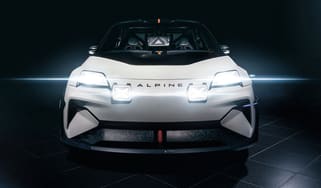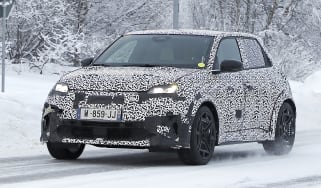Alpine A290 GTS 2025 review – is the Renault 5 relative a true hot hatch?
Alpine’s all-electric future starts with the Renault 5-based A290. Does it have enough edge to warrant the Alpine badge?
Few new EVs have been as hotly anticipated as the Alpine A290, the high-performance twin to the new Renault 5. In concept, it’s a breath of fresh air for a number of reasons. This is a fast EV that doesn’t cost the earth (£33,500, or £37,500 for the GTS version tested here), doesn’t weigh two tons, isn’t all about outright power, and promises to offer traditional hot hatch thrills in a relatively compact body. Alpine has thoroughly re-engineered the Renault 5 to deliver on this brief, with the brilliant A110 being used as a benchmark throughout development to make the A290 feel like a true Alpine. It all sounds very promising.
There’s a lot riding on the A290’s success. Alpine needs to become a cost-effective contributor to the wider Renault Group, and the A290 is its first true volume product built with this goal in mind. An affordable price will be a key factor in achieving this, of course, and at £33,500 the base 178bhp GT model costs the same as Mini’s Cooper E Sport. Above this, you’ve a choice of either the GT Premium or GT Performance for £36,000, the latter being more sparse on equipment than the Premium but wound up to 217bhp. The £37,500 GTS combines the 217bhp motor with more generous equipment levels. Like the Renault 5, the A290 is front-wheel-drive; an all-wheel-drive version probably would have inflated the cost and weight too far beyond a viable business case, and changed the car’s character. All A290 variants are powered by the same 52kWh battery.
The A290 will be followed by further all-electric Alpines: the A390 sports crossover due for launch this year, and a sports car successor to the A110. They’ll be bespoke platform builds and won’t be twinned with Renault models: the A290 is the only new Alpine model that will be built on a Renault platform.
More reviews
A skateboard-style chassis with the battery pack mounted in the floor, the AmpR platform also features a multi-link rear suspension layout rather than the torsion-beam set-up common to many superminis. The A290 also gets a whole new front end with its own aluminium subframe to mount its bespoke springs and dampers to, and hydraulic bump-stops all round. It’s a full 60mm wider than the R5 (which also makes it 60mm wider than an old Clio 197, incidentally), for a significantly wider footprint and sits on 19-inch wheels (with a choice of two designs, and three specifically designed Michelin tyres). The electric motor’s calibration differs from the R5’s, too, with the driving modes, regen behaviour and torque management all developed independently from those of the Renault. The brakes are also different, with front calipers taken from the A110.
Speaking of the A110, achieving that car’s blend of involvement and usability has been one of the goals for the A290, which is evident straight away. It feels grown up, refined and easy to settle into, without any undue harshness. There is an underlying firmness to the ride, particularly over small ridges and bumps, but it is a hot hatch after all, and the payoff is a flat cornering stance and good control over the A290’s mass (1479kg) on undulating surfaces. The multi-link rear suspension and hydraulic bump stops contribute to this, making the A290 feel more sophisticated than you’d expect for a supermini.
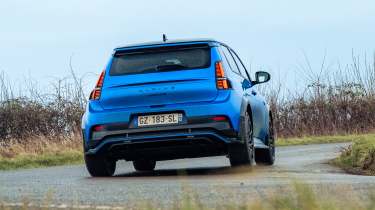
The brake-by-wire system blends the regular brakes and regenerative braking from the motor. Despite the interplay between the two, pedal feel is consistent and stopping power reassuring. A toggle switch on the steering wheel allows you to select three levels of regen. The lightest is modelled on the engine braking generated from the A110’s turbocharged four-cylinder engine; the heaviest is closer to the one-pedal drive mode seen in other EVs, although far less extreme than most. There is a fourth setting: to switch the regen off completely and, unless you’re travelling downhill, Alpine’s engineers say that’s actually the most energy-efficient mode of all. The lower regen settings help make the driving experience more fluid, allowing you to float into and through corners without the heaving deceleration effect of high regen.
There’s a further button on the wheel: an ‘OV’ button, for ‘overtake’ – so named after the similar switch on the steering wheel in Alpine’s F1 cars. It doesn’t actually give you any extra power – instead it ramps the accelerator map more swiftly to 100 per cent. Push it while your foot is already at the stop, and nothing happens; push it while you’re travelling along on a gentle ‘throttle opening’ and the car shoots forward abruptly (almost disconcertingly so). You have to hold the button down to maintain the OV map; let go and it reverts to its regular setting. Ultimately, it’s more of a gimmick than a useful tool.
There are multiple driving modes, accessed by another control on the wheel: Normal, Sport, Save (to conserve the battery level as best as possible) and Personal, to mix and match settings for the accelerator map, power steering weight and the piped-in sound which rises with speed (based on frequencies from the electric motor itself, rather than a synthesised engine note). The drive mode switch is shaped like a rotary clickwheel but is actually a push button, which is a little frustrating to operate. You have to cycle through the modes one by one, and if you accidentally double-press you must go back to the beginning.
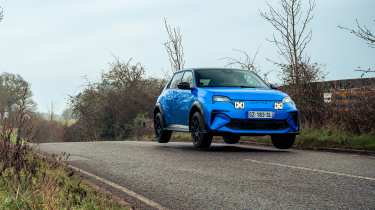
The A290’s steering is light in the Normal setting, and quite darty off centre. This gives it a feeling of agility but to be smooth, it helps to be calm with your hands. There’s more weight to work against in Sport mode but the feel from the rack remains muted – unless you're putting full power down on a bumpy road, at which point it gets quite lively, tugging at your hands even in a straight line. For some this will be part of the fun in a hot hatch, but it can make the A290 feel busy. The progressive throttle map, which has been modelled after the A110’s, allows you to smoothly deploy the full 221lb ft from the motor, without the instant and sometimes disconcerting kick up the road you get in other fast EVs.
The GTS’s 217bhp motor has 1479kg (hardly lightweight but moderately trim for an EV) to move, and it makes the A290 feel swift rather than truly quick. That’s fine by us, though, as it allows you to enjoy its performance for more of the time. That performance is harnessed by a grippy, stable chassis (this test car is fitted with Michelin’s Pilot Sport 5 S tyres, specially developed for the A290) with a four-square stance and neutral handling balance. You can hustle it along without the sense that it’ll bite back, leaning on the resilient front end and bringing the rear gently into play by lifting the throttle into corners. There isn’t the ultimate adjustability or feedback of an old Renault Sport hatch, but there is fun to be had.
All the more so on track, where the A290’s lateral and longitudinal stability, and braking performance are truly impressive. It can be a playful car, too; accelerate into a corner and lift from the throttle and it pivots into lift-off oversteer in the manner of a traditional hot hatch. There is no limited-slip differential, instead the A290 uses torque vectoring by braking – on bumpy, damp roads you don’t always get consistent levels of slip under power, but on a dry circuit it hooks up nicely out of slow hairpins and the nose stays planted, even when a wheel is unloaded over a kerb.
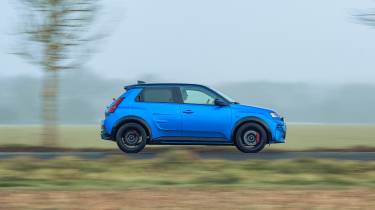
The A290’s overall feel, however, is of a warm hatch rather than a hot one. It’s less edgy and eager than you might expect for a French hot hatch, and some drivers may crave something a little more exhilarating. There’s nothing wrong with the way the A290 drives: its balance is superb (aided by the low centre of gravity and 53:47 front:rear weight distribution), and Alpine’s approach to make it a car that drives in an uncomplicated way, and largely in the manner of a traditional petrol hatchback, is a likeable one. There’s just something indefinable that’s missing from the experience in terms of excitement and engagement, and it’s not just the presence of a petrol engine, or a more potent power-to-weight ratio. More feedback and a more eager edge to its dynamics would make it that much more involving, which is exactly what Alpine could deliver with a potential A290 S or R.
This car’s aim, however, is to appeal to a wide range of customers, many of whom will be new to the Alpine brand and perhaps new to EVs, too. In that sense, its style, easy driving manners in urban quarters and tidy handling further afield give it the broad, smooth-edged remit it needs to fit its brief.
Price and rivals
The A290 is available to order now and starts from £33,500 for the entry-level 178bhp car, stretching to £38,500 for the top-spec Premiere Edition (limited to 1955 examples). In between, there’s the GT Premium and GT Performance (£36,000) and the £37,500 GTS.
Natural rivals are scarce: there aren’t many electric hot hatches out there at the moment. One that Alpine UK namechecks directly is the new electric Mini Cooper, which starts from £30,120. Our experience of both cars in isolation suggests the Alpine is more dynamically well resolved than the Mini.
The A290 is a more characterful and enjoyable car than the VW ID.3 GTX, and its Cupra Born sister car. A closer match for character is the Abarth 500e, which starts from £29,975 but generates less power and torque than the Alpine.
Hyundai’s Ioniq 5 N remains the most exciting electric performance hatchback we’ve driven, but it’s by no means a direct rival to the A290: it’s bigger (closer to an SUV in size than a hatchback), much more expensive (£65k) and massively more potent (641bhp). To drive, its twin-motor all-wheel-drive powertrain, simulated gearchanges, fake ‘engine’ noises and extensive drive mode customisation make it a completely different proposition to the more conventional Alpine.
You could argue the Alpine A290’s biggest rival is the Renault 5 on which it’s based, which packs plenty of design appeal for significantly less cash (£22,995), and for some buyers, may offer engagement enough.
Alpine A290 GTS specs
| Motor | Single, front-mounted |
| Power | 217bhp/162kW |
| Torque | 221lb ft |
| Weight | 1479kg |
| Tyres as tested | Michelin Pilot Sport 5 S |
| 0-62mph | 6.4sec |
| Top speed | 106mph |
| Basic price |
From £33,500 GTS from £37,500 |
